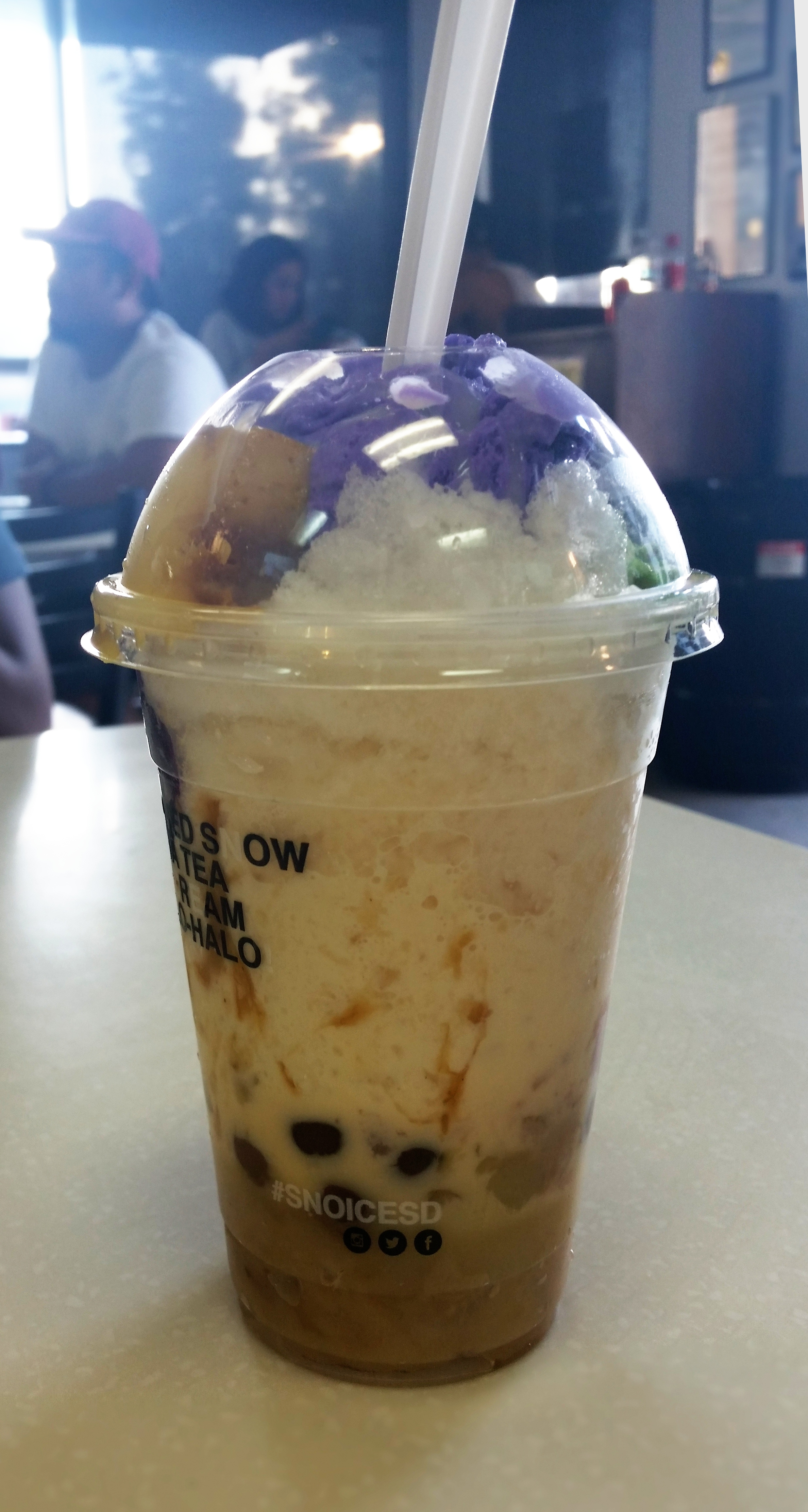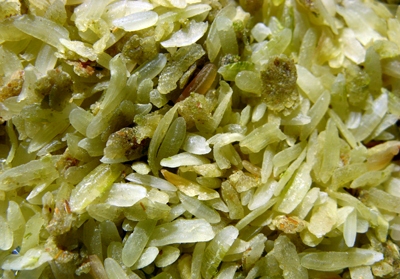|
Iskrambol
Iskrambol, also known as ice scramble, is a Filipino frozen dessert made from shaved ice with banana extract and evaporated milk with sugar (or condensed milk) It is then topped with a variety of ingredients including powdered milk, marshmallows, strawberry syrup, chocolate syrup, pinipig, tapioca pearls, and sprinkles, among others. The regular banana extract flavored dessert is characteristically dyed pink while other flavors may be dyed accordingly (e.g. dark brown from the chocolate syrup used in flavoring). It is usually sold by street vendors and is a popular dessert among children for its bright colors and inexpensive cost. The name of the dessert is derived from either the method of preparation of the dessert, wherein the ice, milk, and flavoring are mixed usually with a giant egg beater, or on the method of eating the dessert, wherein the ingredients are stirred ("scrambled") with the use of the included straw or spoon. In terms of taste and color, it is reminisce ... [...More Info...] [...Related Items...] OR: [Wikipedia] [Google] [Baidu] |
Halo-halo
Halo-halo, correctly spelled ''haluhalo'', Tagalog for "mixed" (the more common spelling instead literally equating to "mix-mix") is a popular cold dessert in the Philippines made up of crushed ice, evaporated milk or coconut milk, and various ingredients including ube jam (ube halaya), sweetened kidney or garbanzo beans, coconut strips, sago, ''gulaman'' (agar), pinipig, boiled taro or soft yams in cubes, flan, slices or portions of fruit preserves and other root crop preserves. The dessert is topped with a scoop of ube ice cream. It is usually prepared in a tall clear glass and served with a long spoon. ''Halo-halo'' is considered to be the unofficial national dessert of the Philippines. The term "''halo-halo''" is supposed to mean "mixed" in English because the dessert is meant to be mixed before being consumed. Although strictly grammatically incorrect, this spelling has come to describe any object or situation composed of a similar, colorful combination of ingred ... [...More Info...] [...Related Items...] OR: [Wikipedia] [Google] [Baidu] |
Philippines
The Philippines (; fil, Pilipinas, links=no), officially the Republic of the Philippines ( fil, Republika ng Pilipinas, links=no), * bik, Republika kan Filipinas * ceb, Republika sa Pilipinas * cbk, República de Filipinas * hil, Republika sang Filipinas * ibg, Republika nat Filipinas * ilo, Republika ti Filipinas * ivv, Republika nu Filipinas * pam, Republika ning Filipinas * krj, Republika kang Pilipinas * mdh, Republika nu Pilipinas * mrw, Republika a Pilipinas * pag, Republika na Filipinas * xsb, Republika nin Pilipinas * sgd, Republika nan Pilipinas * tgl, Republika ng Pilipinas * tsg, Republika sin Pilipinas * war, Republika han Pilipinas * yka, Republika si Pilipinas In the recognized optional languages of the Philippines: * es, República de las Filipinas * ar, جمهورية الفلبين, Jumhūriyyat al-Filibbīn is an archipelagic country in Southeast Asia. It is situated in the western Pacific Ocean and consists of around 7,641 islands t ... [...More Info...] [...Related Items...] OR: [Wikipedia] [Google] [Baidu] |
Pinipig
''Pinipig'' is a flattened rice ingredient from the Philippines. It is made of immature grains of glutinous rice pounded until flat before being toasted. It is commonly used as toppings for various desserts in Filipino cuisine, but can also be eaten plain, made into cakes, or mixed with drinks and other dishes. Production ''Pinipig'' is made solely from glutinous rice (''malagkit'' or "sticky" rice). The grains are harvested while still green. They are husked and the chaff is separated from the grain (traditionally using large flat winnowing baskets called ''bilao''). The resulting bright green kernels are then pounded in large wooden mortars and pestles until flat. They are then toasted dry on pans or baked until crisp. Description ''Pinipig'' are characteristically light green in color when fresh, but usually become yellowish white to brown when toasted. They superficially resemble grains of oats, and are often confused with puffed rice. The texture is crunchy on the ext ... [...More Info...] [...Related Items...] OR: [Wikipedia] [Google] [Baidu] |
Sorbetes
Sorbetes is a traditional ice cream originating from the Philippines and uniquely characterized by the use of coconut milk and/or carabao milk. Often pejoratively called "dirty ice cream", it is distinct from the similarly named sorbet and sherbet. It is traditionally peddled in colorful wooden pushcarts by street vendors called "''sorbeteros''". It is served in various flavors (usually dyed in bright colors) in small wafer or sugar cones and more recently, as a pandesal bread ice cream sandwich. History and formulation Ice was first introduced as a luxury item to the Philippines in 1847, when an American company, Russell & Sturgis, imported 250 tons of ice into the then Spanish colony. They acquired the tax-free rights to import ice into the Philippines by Royal Order in 1848. The company built the first ice plant in the Philippines in Calla Barraca, Binondo. The company went bankrupt in 1881 and was acquired by the businessman Julio Witte. Ice cream was already known to F ... [...More Info...] [...Related Items...] OR: [Wikipedia] [Google] [Baidu] |
Lamaw
Lamaw, also known as buko lamaw, is a Filipino dessert or beverage made from scraped young coconut meat (''buko'') in coconut water with milk and sugar (or condensed milk), and saltines or biscuits. Variations can add ingredients like peanuts, graham crackers, or orange-flavored softdrinks. Ice cubes are also commonly added to chill the dessert. It is usually made from freshly gathered coconuts, and is commonly served within the coconut shell itself. It originates from the Visayas and Visayan areas of Mindanao and is a traditional '' merienda'' for farmers working in the fields in rural areas. The name of the dessert is from Visayan ''lamaw'', meaning " swill" or " slop", due to its appearance. The term can sometimes also be used to refer to similar desserts made from papaya, star apple, or avocado with milk and sugar. See also * Avocado and milk in ice (Avocado lamaw) * Buko pie * Buko salad * Halo-halo * Ice buko * Samalamig Samalamig, also known as palamig, is ... [...More Info...] [...Related Items...] OR: [Wikipedia] [Google] [Baidu] |
Ice Buko
Ice buko, also known as buko ice candy or coconut popsicle, is a Filipino frozen dessert made from condensed milk, young coconut (''buko'') strips, and coconut water. It is basically a frozen version of the buko salad. They can be sold on popsicle sticks or in plastic bags as ice candy. They commonly include other ingredients like peanuts, pinipig (toasted young rice), macapuno, pandan leaf extracts, various fruits, or sweetened mung beans (or adzuki beans). They are popular desserts during the summer and are commonly sold by sari-sari stores and ''sorbeteros''. See also * Buko salad * Halo-halo * Ice scramble * Lamaw Lamaw, also known as buko lamaw, is a Filipino dessert or beverage made from scraped young coconut meat (''buko'') in coconut water with milk and sugar (or condensed milk), and saltines or biscuits. Variations can add ingredients like peanu ... * Sorbetes References {{Ice-based beverages and desserts Philippine desserts Ice-based desserts Foo ... [...More Info...] [...Related Items...] OR: [Wikipedia] [Google] [Baidu] |


.jpg)